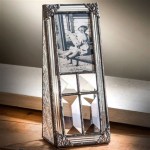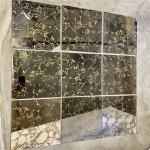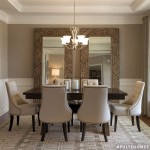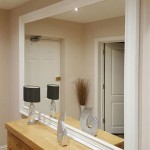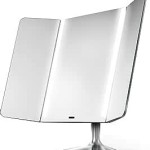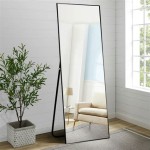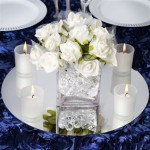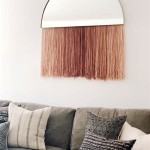Mirrors with Rosettes: A Decorative Accent with Historical Roots
Mirrors with rosettes offer a decorative touch to interior design, adding a touch of elegance and historical charm. The rosette, a circular ornament resembling a rose, serves as a decorative embellishment around the mirror's frame or within the mirrored surface itself. This article will explore the history, design variations, materials, and application of mirrors with rosettes in interior design.
Rosettes have a rich history dating back to antiquity. Ancient Egyptians, Greeks, and Romans utilized rosette motifs in their architecture, sculptures, and decorative arts. These cultures often associated rosettes with symbolic meanings, representing concepts such as the sun, life, and eternity. The rosette design continued to be prevalent in various forms throughout history, appearing in Gothic architecture, Renaissance art, and Baroque ornamentation.
The inclusion of rosettes in mirror design emerged as mirrors gained popularity in interior decoration. Early mirrors were often small and expensive, making them luxury items. The addition of ornate frames, including those embellished with rosettes, further enhanced their status as precious objects. Rosettes provided a delicate and intricate detail that complemented the reflective surface of the mirror, contributing to its overall aesthetic appeal.
Mirrors with rosettes can be broadly categorized based on their design and placement of the rosettes. One common type features rosettes incorporated into the frame itself. These rosettes can be carved directly into the frame material or applied as separate decorative elements. Another variation involves etching or painting rosette designs onto the mirror's surface, creating a subtle and elegant effect. Some designs incorporate both frame and surface rosettes for a more elaborate look.
The materials used in crafting mirrors with rosettes vary depending on the desired aesthetic and budget. Historically, materials like wood, plaster, and metal were commonly used for creating rosette embellishments. Wood offered the advantage of being easily carved into intricate shapes, while plaster allowed for detailed molding. Metal rosettes, often made of brass or bronze, provided a more durable and luxurious option. Modern mirrors with rosettes may utilize a wider range of materials, including resin, plastic, and even glass, offering more versatility in design and affordability.
The size and style of rosettes used in mirror design can significantly impact the overall appearance. Smaller, more delicate rosettes tend to create a subtle and refined look, suitable for spaces with a minimalist or understated aesthetic. Larger, more prominent rosettes can make a bolder statement, adding a touch of grandeur and opulence to a room. The style of the rosette itself can also vary, ranging from simple, geometric designs to more complex, floral-inspired patterns.
Mirrors with rosettes can be incorporated into a variety of interior design styles. They are a natural fit for traditional or classically inspired interiors, complementing antique furniture and ornate décor. In such settings, mirrors with rosettes can enhance the overall sense of elegance and historical charm. However, mirrors with rosettes can also be successfully integrated into more contemporary spaces. A simple, modern frame with subtle rosette detailing can add a touch of visual interest without overwhelming the overall design.
When selecting a mirror with rosettes, it's essential to consider the existing décor and the desired atmosphere. The size and style of the mirror should be proportionate to the surrounding space and furniture. The color and finish of the frame and rosettes should complement the existing color palette. For example, a gold-framed mirror with intricate rosettes might be ideal for a luxurious living room, while a silver-framed mirror with simpler rosettes could be more suitable for a modern bathroom.
The placement of a mirror with rosettes can also influence its impact on the space. Positioning a mirror opposite a window can help to maximize natural light and create an illusion of spaciousness. Hanging a mirror above a fireplace or console table can serve as a focal point and enhance the room's visual appeal. In smaller spaces, strategically placed mirrors with rosettes can help to create a sense of depth and openness.
Caring for mirrors with rosettes requires attention to the specific materials used. Dusting regularly with a soft cloth is essential for maintaining the mirror's shine and preventing the buildup of grime on the rosettes. For more stubborn dirt, a slightly damp cloth can be used, followed by immediate drying to prevent water damage to the frame or reflective surface. Avoid using harsh chemicals or abrasive cleaners, as these can damage the delicate rosette details.
The versatility of mirrors with rosettes allows them to be incorporated into various rooms throughout the house. In the living room, a large mirror with rosettes above a mantelpiece can create a grand focal point. In the dining room, a mirror strategically placed to reflect a chandelier can enhance the ambiance. In the bedroom, a smaller mirror with rosettes can add a touch of elegance to a dressing table. Even in hallways and entryways, mirrors with rosettes can serve both functional and decorative purposes.

12 Brass Flower Mirror Rosettes Zc144

Cast Brass Tudor Rose Mirror Rosette Rough Old Glass

20thc Large Distressed Mirror With Rosette Detail At 1stdibs Rosettes Brass

Villa House Rosette Mirror Multiple Options Clayton Gray Home

Antique Mirror Backsplash Jockimo

11 Mirror Rosettes Ideas Corner Antique

Rosette Wall Mirror Mirrors Ethan Allen

Antique Mirrors Residential Gallery Anchor Ventana Glass

Mirror Walls Builders Glass Of Bonita Inc

Silver Mirror Rosettes Antique Tiles Decor Bedroom Design

